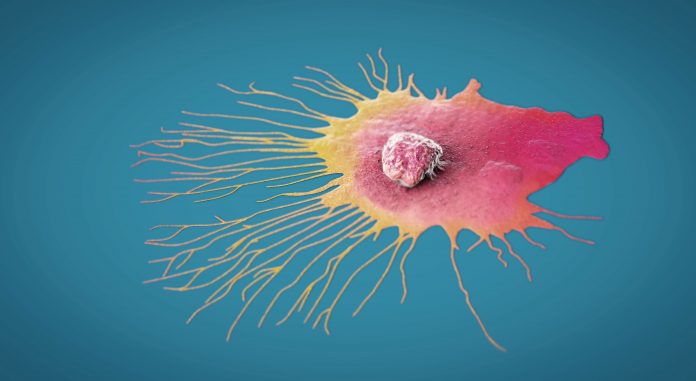
Scientists at the University of Turku collaborated with an international multidisciplinary team to reveal for the first time how tissue stiffness determines cell positioning and regulates all types of cell migration—ranging from the neuronal growth cone to dissemination of malignant cancer cells in brain tumors and breast cancer.
“The prevailing view among scientists was that all cell types prefer high-rigidity environments and migrate towards increasing stiffness. This process has been coined the term ‘durotaxis,’ i.e., migration towards hard, from Greek and Latin,” said doctoral candidate Aleksi Isomursu.
The study is published in Nature Materials.
“How cells sense tissue stiffness to guide cell migration is a fundamental question in development, fibrosis, and cancer. Although durotaxis—cell migration towards increasing substrate stiffness—is well established, it remains unknown whether individual cells can migrate towards softer environments,” write the investigators.
“Here, using microfabricated stiffness gradients, we describe the directed migration of U-251MG glioma cells towards less stiff regions. This ‘negative durotaxis’ does not coincide with changes in canonical mechanosensitive signaling or actomyosin contractility. Instead, as predicted by the motor–clutch-based model, migration occurs towards areas of ‘optimal stiffness,’ where cells can generate maximal traction.
“In agreement with this model, negative durotaxis is selectively disrupted and even reversed by the partial inhibition of actomyosin contractility. Conversely, positive durotaxis can be switched to negative by lowering the optimal stiffness by the downregulation of talin—a key clutch component.
“Our results identify the molecular mechanism driving context-dependent positive or negative durotaxis, determined by a cell’s contractile and adhesive machinery.
“I was visiting the University of Minnesota for a research project and noticed that brain cancer cells grown on engineered substrates with alternating stiffness show the opposite behavior they turned towards soft,” noted Isomursu.
This observation launched an interdisciplinary research project involving cancer cell biology, computational modeling, and engineering that involved researchers from three continents. The researchers eventually uncovered the basic mechanism all cell types use to steer themselves towards their optimal environment.
“I experimented with different types of drugs and identified ones that could make brain cancer cells stop moving or change direction,” explained Mathilde Mathieu, PhD, a postdoctoral scientist.
Identification of the mechanism of cell steering could provide explanations for a number of steps in cancer dissemination, e.g., how cancer cells migrate out from the stiff core of a breast tumor.
“These findings have been gaining a lot of interest, and we have even played around with the idea of launching a new term—‘mollitaxis,’ migration towards soft,” said Johanna Ivaska, PhD, principal investigator of the laboratory at the University of Turku.













